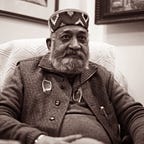Maharishi Mahesh Yogi — The Science of Being and Art of Living
Over the weeks I have introduced you to great Indian spiritual teachers, many of whom were influential in spreading the ancient teachings of our country to the West. This week, the man I wish to write about will be known to many of you as the man who introduced Transcendental Meditation (TM) to the world, the great Maharishi Mahesh Yogi. I admire him immensely for the vision he held, which was to rebuild the world according to Vedic principles. I met this inspirational Soul in Delhi in 1983, and what I remember most about that meeting is the beautiful fragrance of lotus and sandalwood that naturally emanated from his body — a sign of a very highly evolved Soul. I feel fortunate to have met him in my lifetime. He developed TM as an accessible meditation technique that could be presented in a scientific, rather than mystical way, to encourage people all over the world to reach their transcendental Self. It is a meditation based on the use of ancient Sanskrit Bija mantras. Bija mantras are transformational seed sounds of particular vibrational frequencies. A Guru or highly evolved spiritual teacher can intuitively tell which particular seed sound will best suit an individual student. Although Maharishi is known by many as the spiritual advisor of celebrities, including the Beatles and the Beach Boys, this does not reflect the depth of his vision or the fact that he introduced a transformative meditation technique to millions of people worldwide.
Maharishi was born on 12 January 1917 to a Hindu family in a small village near Jabalpur in Madhya Pradesh and given the birth name Mahesh Prasad Varma. There are not many stories about his childhood, but we know he graduated from the University if Allahabad in 1942 with a Masters in Psychics — his capacity to explain his meditation techniques in scientific terms is no surprise. His intellectual mind was balanced by the deeply spiritual aspect of his nature. He was a disciple of Swami Brahmananda Saraswati, known affectionately as Guru Dev (Divine teacher), a great spiritual teacher of the Advaita tradition, consolidated by Adi Sri Shankaracharya in the 8th century. By the time Guru Dev passed in 1953, Maharishi had studied with him for thirteen years. Following his death Maharishi travelled to Uttarkashi, in the Himalayas, where he spent two years. It was while there he decided to travel the world to establish his Spiritual Regeneration Movement, teaching the practice of TM.
He toured India, Malaysia, and Hawaii, before arriving in America in 1959, a year he declared to be “the year of global awakening”. Tours of the United Kingdom, where he first met the Beatles, and Europe followed. He wished to spread his Guru’s teachings, as he said: “Right from the beginning the whole purpose was to breathe in his breath. This was my ideal. The whole purpose was just to assume myself with Guru Dev.” His practical approach to a meditation technique that could be adopted by anyone, together with the beautifully simple way he taught quickly appealed to thousands of people, including famous people like Clint Eastwood, the singer Donovan and the Beach Boys. At his first lecture in Los Angeles, he opened the evening with the statement:” Mankind was not born to suffer, mankind was born to enjoy. The Purpose of life is to expand happiness.” Statements like this caught people’s attention. They were not being told to undertake disciplines, or to undergo rigorous practices, simply to devote 20 minutes twice a day to sitting with a sound personally selected for them.
Maharishi believed that a global revolution, a world of people practising TM, could shift global consciousness to make the changes needed to create harmony and peace on the earth. The purpose of life, he wrote, “is to cultivate and give — cultivate the Divine power, the Divine intelligence, happiness and abundance, and give it out to all of creation. This is the high purpose of the life of man, and it is fortunate to find that every man is capable of reaching this by improving the conscious capacity of his mind and consciously contacting the field of the absolute energy, peace, happiness and abundance of the eternal, Divine consciousness.” He only published three books in his lifetime, and I find myself returning frequently to the first of those, “The Science of Being and Art of Living”, published originally in 1963, for the simple and accessible way he deals with profound issues, such as the true nature of experiences and the art of thinking.
Although many people today practise TM for its proven practical benefits, like a clearer mind and improved health, these are only surface benefits. It is like sitting in a boat in the ocean, where all we can see is the waves on the surface. These waves are not the ocean; the ocean is deep and silent once we dive beneath the surface. This is the goal of TM, to lead us away from the surface mind to the bottomless ocean of pure consciousness. Whatever someone’s reason for practising TM might be, I have no doubt but that they will, over time, arrive at their depth.
Maharishi left his body on 5th February 2008, but his legacy lives on through the ancient technique he adapted and breathed new life into. Some would say he did not succeed in his mission in his lifetime, but I believe he achieved something extraordinary, in opening the minds of millions to look where they otherwise might never have ventured.
